National team United States Name Duke Kahanamoku | Weight 190 lb (86 kg) Height 6.1 ft (190 cm) Role Swimmer | |
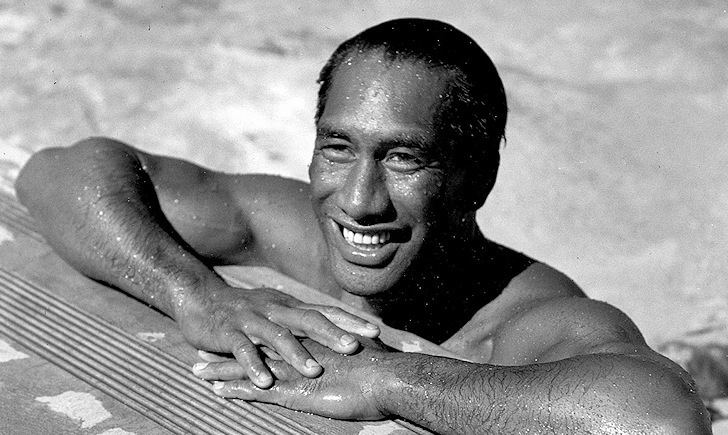 | ||
Full name Duke Paoa Kahinu Mokoe Hulikohola Kahanamoku Spouse Nadine Alexander (m. 1940–1968) Siblings Samuel Kahanamoku, Bernice Kahanamoku Parents Duke Halapu Kahanamoku, Julia Paʻakonia Lonokahikina Paoa Movies Mister Roberts, Wake of the Red Witch, Girl of the Port, Isle of Sunken Gold, The Rescue Similar People Eddie Aikau, Johnny Weissmuller, Cecil Healy, Pua Kealoha, Henry Taylor | ||
Duke kahanamoku feature story on bitv
Duke Paoa Kahinu Mokoe Hulikohola Kahanamoku (August 24, 1890 – January 22, 1968) was a Native Hawaiian competition swimmer who popularized the ancient Hawaiian sport of surfing. He was born towards the end of the Kingdom of Hawaii, just before the overthrow, living into statehood as a United States citizen. He was a five-time Olympic medalist in swimming. Duke was also a law enforcement officer, an actor, a beach volleyball player and businessman.
Contents
- Duke kahanamoku feature story on bitv
- Duke kahanamoku s original australian surfboard
- Early years
- Career
- Duncan v Kahanamoku
- Death and legacy
- References
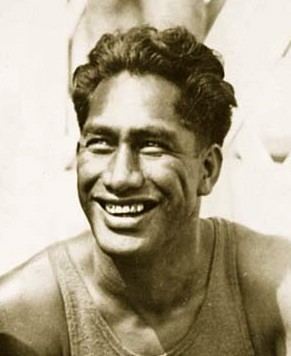
Duke kahanamoku s original australian surfboard
Early years
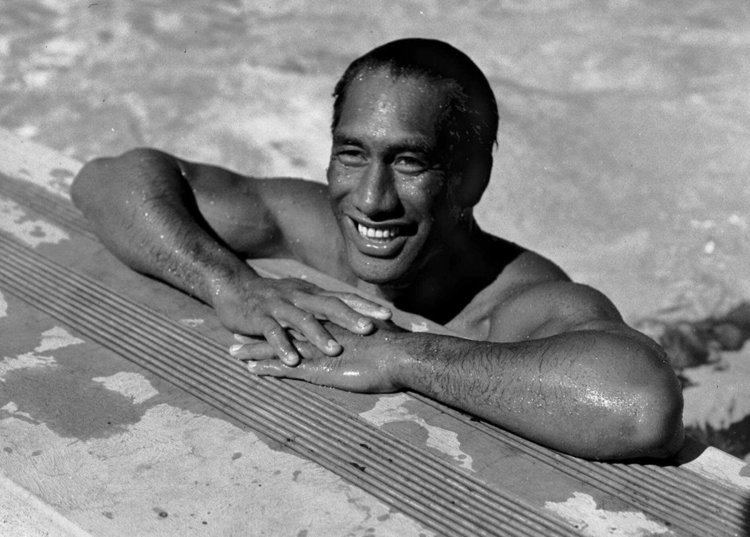
According to Kahanamoku, he was born in Honolulu at Haleʻākala, the home of Bernice Pauahi Bishop which was later converted into the Arlington Hotel. He had five brothers and three sisters, including Samuel Kahanamoku. In 1893, the family moved to Kālia, Waikiki (near the present site of the Hilton Hawaiian Village), to be closer to his mother's parents and family. Duke grew up with his siblings and 31 Paoa cousins. Duke attended the Waikiki Grammar School, Kaahumanu School, and the Kamehameha Schools, although he never graduated because he had to quit to help support the family.
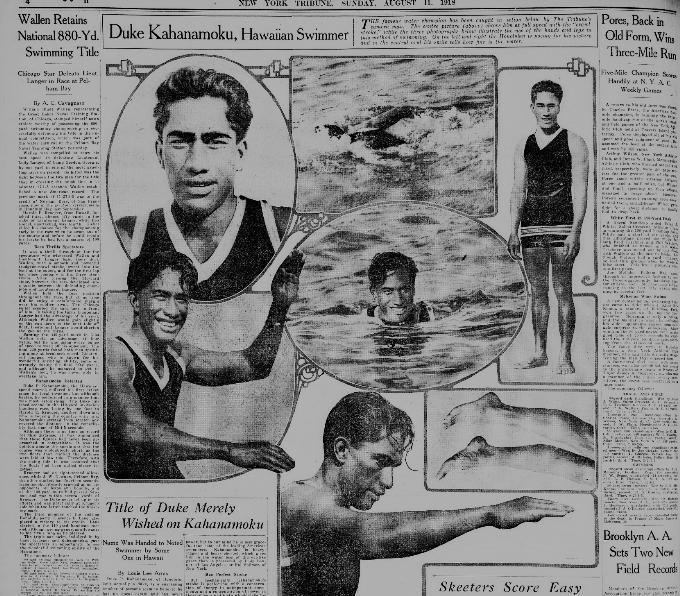
"Duke" was not a title or a nickname, but a given name. He was named after his father, Duke Halapu Kahanamoku, who was christened by Bernice Pauahi Bishop in honor of Prince Alfred, Duke of Edinburgh, who was visiting Hawaii at the time. His father was a policeman. His mother Julia Paʻakonia Lonokahikina Paoa was a deeply religious woman with a strong sense of family ancestry.

Even though not of the formal Hawaiian Royal Family, his parents were from prominent Hawaiian ohana (family); the Kahanamoku and the Paoa ohana were considered to be lower-ranking nobles, who were in service to the aliʻi nui or royalty. His paternal grandfather was Kahanamoku and his grandmother, Kapiolani Kaoeha (sometimes spelled Kahoea), a descendant of Alapainui. They were kahu, retainers and trusted advisors of the Kamehamehas, to whom they were related. His maternal grandparents Paoa, son of Paoa Hoolae and Hiikaalani, and Mele Uliama were also of aliʻi descent.
Growing up on the outskirts of Waikiki, Kahanamoku spent his youth as a bronzed beach boy. At Waikiki Beach he developed his surfing and swimming skills. In his youth, Kahanamoku preferred a traditional surf board, which he called his "papa nui", constructed after the fashion of ancient Hawaiian "olo" boards. Made from the wood of a koa tree, it was 16 feet (4.9 m) long and weighed 114 pounds (52 kg). The board was without a skeg, which had yet to be invented. In his later career, he would often use smaller boards but always preferred those made of wood.
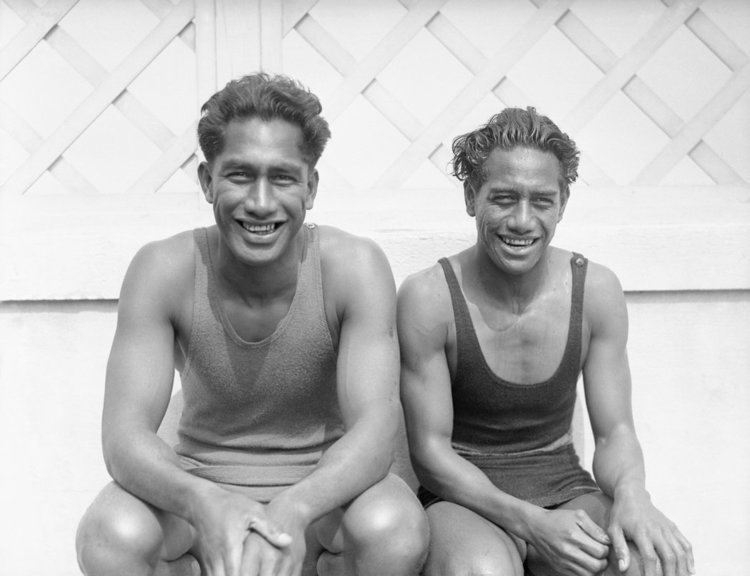
On August 11, 1911, Kahanamoku was timed at 55.4 seconds in the 100 yards (91 m) freestyle, beating the existing world record by 4.6 seconds, in the salt water of Honolulu Harbor. He also broke the record in the 220 yd (200 m) and equaled it in the 50 yd (46 m). But the Amateur Athletic Union (AAU), in disbelief, would not recognize these feats until many years later. The AAU initially claimed that the judges must have been using alarm clocks rather than stopwatches and later claimed that ocean currents aided Kahanamoku.
Career
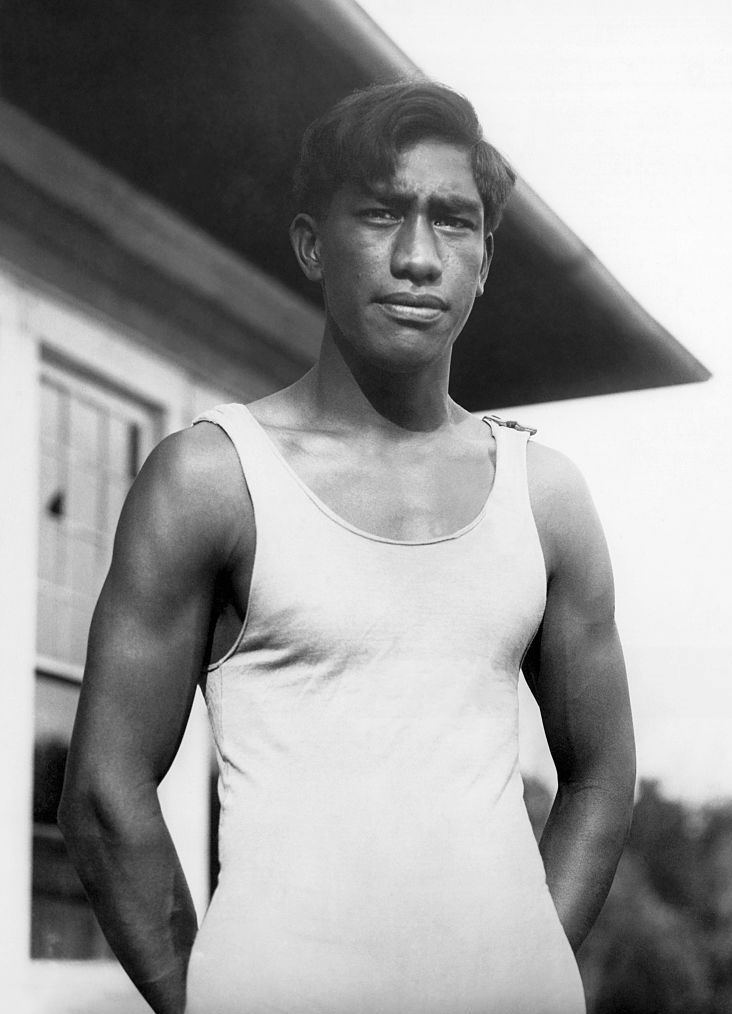
Kahanamoku easily qualified for the U.S. Olympic swimming team in 1912. At the 1912 Summer Olympics in Stockholm, he won a gold medal in the 100-meter freestyle, and a silver medal with the second-place U.S. team in the men's 4×200-meter freestyle relay. During the 1920 Olympics in Antwerp, he won gold medals both in the 100 meters (bettering fellow Hawaiian Pua Kealoha) and in the relay. He finished the 100 meters with a silver medal during the 1924 Olympics in Paris, with the gold going to Johnny Weissmuller and the bronze to Duke's brother, Samuel Kahanamoku. At age 34, this was Kahanamoku's last Olympic medal. He also was an alternate for the U.S. water polo team at the 1932 Summer Olympics.
Between Olympic competitions, and after retiring from the Olympics, Kahanamoku traveled internationally to give swimming exhibitions. It was during this period that he popularized the sport of surfing, previously known only in Hawaii, by incorporating surfing exhibitions into these visits as well. His surfing exhibition at Sydney's Freshwater Beach on December 24, 1914 is widely regarded as a seminal event in the development of surfing in Australia. The board that Kahanamoku built from a piece of pine from a local hardware store is retained by the Freshwater Surf Club. There is a statue of Kahanamoku on the Northern headland of Freshwater Beach, New South Wales. He made surfing popular in mainland America first in 1912 while in Southern California.
During his time living in Southern California, Kahanamoku performed in Hollywood as a background actor and a character actor in several films. In this way, he made connections with people who could further publicize the sport of surfing. Kahanamoku was involved with the Los Angeles Athletic Club, acting as lifeguard and competing on both swimming and water polo teams.
While living in Newport Beach, California on June 14, 1925, Kahanamoku rescued eight men from a fishing vessel that capsized in heavy surf while attempting to enter the city's harbor. 29 fishermen went into the water and 17 perished. Using his surfboard, he was able to make quick trips back and forth to shore to increase the number of sailors rescued. Two other surfers saved four more fishermen. Newport's police chief at the time called Duke's efforts "the most superhuman surfboard rescue act the world has ever seen". It also caused U.S. lifeguards to begin using surfboards in their water rescues.
In 1940, he married Nadine Alexander, who accompanied him when he traveled. Kahanamoku was the first person to be inducted into both the Swimming Hall of Fame and the Surfing Hall of Fame. The Duke Kahanamoku Invitational Surfing Championships are named in his honor. He is a member of the U.S. Olympic Hall of Fame. He served as sheriff of Honolulu, Hawaii from 1932 to 1961, serving 13 consecutive terms. During this period, he also appeared in a number of television programs and films, such as Mister Roberts (1955).
Kahanamoku was a friend and surfing companion of heiress Doris Duke, who built a home (now a museum) on Oahu named Shangri-la.
Duncan v. Kahanamoku
In 1946, Kahanamoku was the pro forma defendant in the landmark Supreme Court case Duncan v. Kahanamoku. While Kahanamoku was a military police officer during World War II, he arrested Duncan, a civilian shipfitter, for public intoxication. At the time, Hawaii, not yet a state, was being administered under the Hawaiian Organic Act which effectively instituted martial law on the island. Duncan was therefore tried by a military tribunal and appealed to the Supreme Court. In a post hoc ruling, the court ruled that trial by military tribunal was, in this case, unconstitutional.
Death and legacy
Kahanamoku died of a heart attack on January 22, 1968, at the age of 77. For his burial at sea a long motorcade of mourners, accompanied by a 30-man police escort, moved across town to Waikiki Beach. Reverend Abraham Akaka, the pastor of Kawaiahao Church, performed the service, a group of beach boys sang Hawaiian songs, including "Aloha Oe", and his ashes were scattered into the ocean. The City of Honolulu commemorated this Waikiki Beach burial site in 1990 with a 9-foot cast bronze statue of Kahanamoku by Jan Gordon Fisher that shows Kahanamoku with outstretched arms in front of his surfboard and honorary Hawaiian spears, and includes a dedication plaque and a historic information marker. The statue's orientation that placed Kahanamoku's back to the sea was initially criticized as being contrary to Hawaiian custom, yet its orientation toward the pedestrian activity and public realm on Kalakaua Avenue created an immensely popular local shrine and tourist locale: the outstretched arms are always adorned with fresh leis. The Kahanamoku statue receives annual tribute ceremonies and thousands of yearly tourist visits. In 1997, the historic public artwork "The Stones of Life", containing four ancient basaltic stones or pōhaku (circa 1500), was installed nearby. A 24-hour live web camera is also installed at the statue so that visitors from around the world can be viewed.
Hawaii music promoter Kimo Wilder McVay capitalized on Kahanamoku's popularity by naming his Waikiki showroom "Duke Kahanamoku's," and giving Kahanamoku a financial interest in the showroom in exchange for the use of his name. It was a major Waikiki showroom in the 1960s and is remembered as the home of Don Ho & The Aliis from 1964 through 1969. The showroom continued to be known as Duke Kahanamoku's until Hawaii showman Jack Cione bought it in the mid-1970s and renamed it Le Boom Boom.
Kahanamoku's name is also used by Duke's Canoe Club & Barefoot Bar, as of 2016 known as Duke's Waikiki, a beachfront bar and restaurant in the Outrigger Waikiki on the Beach Hotel. There is a chain of restaurants named after him in California, Florida and Hawaii called Duke's.
On August 24, 2002, the 112th anniversary of Kahanamoku's birth, the U.S. Postal Service issued a first-class commemorative stamp with Duke's picture on it. The First Day Ceremony was held at the Hilton Hawaiian Village in Waikiki and was attended by thousands. At this ceremony, attendees could attach the Duke stamp to an envelope and get it canceled with a First Day of Issue postmark. These First Day Covers are very collectible.
On February 28, 2015, a monument featuring a replica of Kahanamoku's surfboard was unveiled at New Brighton beach, Christchurch, New Zealand in honour of the 100th anniversary of Kahanamoku's visit to New Brighton.
On August 24, 2015, a Google Doodle honored the 125th anniversary of Duke Kahanamoku's birthday.
